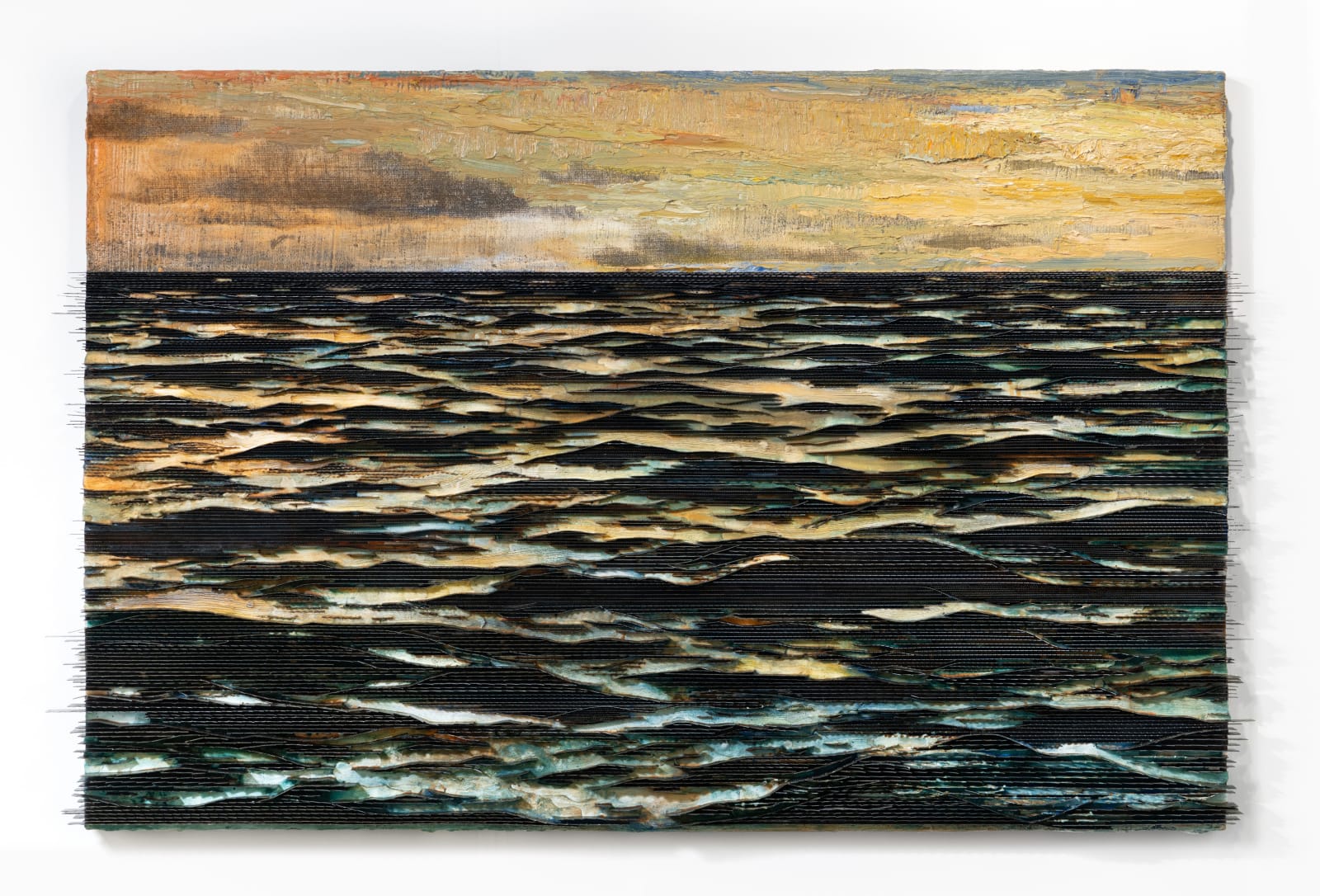



Yoan Capote Cuban, b. 1977
Aguas Territoriales (Cómo Llegó la Noche), 2024
Saw blades, oil, plaster on jute mounted on wooden panels
100 x 150 cm. (39 3/8 x 59 in.)
Copyright The Artist
Further images
Yoan Capote’s Aguas Territoriales series is a poignant exploration of the sea as both subject and metaphor. Continuing his engagement with the seascape motif, Capote employs the horizon line a...
Yoan Capote’s Aguas Territoriales series is a poignant exploration of the sea as both subject and metaphor. Continuing his engagement with the seascape motif, Capote employs the horizon line a site of visual and conceptual tension. In some works, stormy seas consume the canvas, dissolving almost into abstraction, while in others, luminous skies of vivid purples, reds, or golds loom over the water, creating a window-like perspective that surrounds the viewer. The series invokes the sensation of being immersed in water, transforming the viewer into an island adrift in an infinite ocean.
Sharing visual affinities with his preceding series Purificación, Isla, and Sentimientos Encontrados, a pivotal innovation in Aguas Territoriales is Capote’s incorporation of saw blades into his material vocabulary. This marks an evolution from his earlier use of fishhooks, which were embedded into his canvases to construct the texture of undulating waves. The saw blades add a new dimension of materiality, their serrated edges evoking an immediate sense of danger upon close inspection. Yet, when viewed from a distance, the blades dissolve into shimmering, hypnotic impressions of water. This duality between beauty and menace serves as a powerful metaphor for the dangers and seductions of migration.
Capote’s Cuban heritage imbues his seascapes with deep political and personal resonance. For Cubans, the horizon has long represented a fraught symbol: an enticing promise of freedom and opportunity, but also a treacherous boundary fraught with peril. The sharp, often blood-stained blades underscore the stark reality faced by those who attempt to cross these watery borders. Migration, immigration, and the geopolitical demarcations of territorial waters are central to Capote’s meditations, making his works both timeless and acutely topical.
Seriality plays a crucial role in Capote’s practice, linking him to a lineage of artists who have repeatedly explored singular subjects under shifting atmospheric conditions. From Caspar David Friedrich’s romantic meditations on the sublime, to the Impressionists’ studies of light and atmosphere, and Hiroshi Sugimoto’s minimalist seascapes, Capote’s work resonates with these traditions. Yet, where these predecessors may have emphasised transcendence or aesthetic contemplation, Capote infuses his seascapes with urgent sociopolitical content.
The dualities within Aguas Territoriales – seduction and peril, beauty and brutality, hope and despair – are heightened by the artist’s transcendental treatment of the sea. The surfaces of his canvases are illuminated by divine, golden light, evoking the sublime majesty of nature. At the same time, the jagged edges of the saw blades provide an ever-present reminder of human suffering and vulnerability. These juxtapositions invite viewers to reflect on themes of displacement and longing, as well as the physical and psychological borders that define the human condition.
In Aguas Territoriales, Capote offers a deeply poetic yet unflinching lens through which to view the sea – not merely as a natural element, but as a charged space laden with history, politics, and existential questions.
Sharing visual affinities with his preceding series Purificación, Isla, and Sentimientos Encontrados, a pivotal innovation in Aguas Territoriales is Capote’s incorporation of saw blades into his material vocabulary. This marks an evolution from his earlier use of fishhooks, which were embedded into his canvases to construct the texture of undulating waves. The saw blades add a new dimension of materiality, their serrated edges evoking an immediate sense of danger upon close inspection. Yet, when viewed from a distance, the blades dissolve into shimmering, hypnotic impressions of water. This duality between beauty and menace serves as a powerful metaphor for the dangers and seductions of migration.
Capote’s Cuban heritage imbues his seascapes with deep political and personal resonance. For Cubans, the horizon has long represented a fraught symbol: an enticing promise of freedom and opportunity, but also a treacherous boundary fraught with peril. The sharp, often blood-stained blades underscore the stark reality faced by those who attempt to cross these watery borders. Migration, immigration, and the geopolitical demarcations of territorial waters are central to Capote’s meditations, making his works both timeless and acutely topical.
Seriality plays a crucial role in Capote’s practice, linking him to a lineage of artists who have repeatedly explored singular subjects under shifting atmospheric conditions. From Caspar David Friedrich’s romantic meditations on the sublime, to the Impressionists’ studies of light and atmosphere, and Hiroshi Sugimoto’s minimalist seascapes, Capote’s work resonates with these traditions. Yet, where these predecessors may have emphasised transcendence or aesthetic contemplation, Capote infuses his seascapes with urgent sociopolitical content.
The dualities within Aguas Territoriales – seduction and peril, beauty and brutality, hope and despair – are heightened by the artist’s transcendental treatment of the sea. The surfaces of his canvases are illuminated by divine, golden light, evoking the sublime majesty of nature. At the same time, the jagged edges of the saw blades provide an ever-present reminder of human suffering and vulnerability. These juxtapositions invite viewers to reflect on themes of displacement and longing, as well as the physical and psychological borders that define the human condition.
In Aguas Territoriales, Capote offers a deeply poetic yet unflinching lens through which to view the sea – not merely as a natural element, but as a charged space laden with history, politics, and existential questions.



